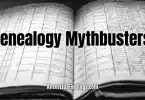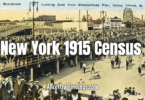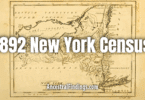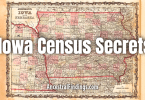The 1860 U.S. Census might be one of the most emotionally charged documents in early American history. On the surface, it looks similar to 1850—names, ages, occupations, birthplaces, property values. But just beneath that is a country on the brink of war. It was taken in a moment when the United States was technically still whole, but very much coming apart.
If you’re researching ancestors during this time, the 1860 census offers a powerful glimpse into their world—whether they were preparing for conflict, trying to make a living, enslaved, recently freed, or pushing west toward opportunity. It’s a document shaped by growing tensions, but also filled with the quiet rhythms of daily life.
What Was Collected in 1860
The 1860 census used nearly the same form as in 1850, which makes it easy to compare across decades. Each household entry includes:
- Full names of every free person
- Age
- Sex
- Color (typically noted as white, Black, or mulatto)
- Occupation
- Value of real estate owned
- Value of personal estate
- Birthplace (state, territory, or foreign country)
- Whether the person had been married within the year
- Whether the person attended school within the year
- Whether the person could read or write (if over age 20)
- Whether the person was deaf, dumb, blind, insane, or “idiotic” (language used at the time)
Also included were slave schedules, which, as in 1850, recorded enslaved individuals by age, gender, and race—but not by name—under the name of their enslaver.
What changed in 1860 was the scale. The country had grown fast—there were now over 31 million people across 33 states and 10 territories. And because of that, this census captured a broader, more diverse snapshot of American life than ever before.
Who Took the Census, and How?
The 1860 census was still taken by U.S. Marshals and their assistants, working under the direction of the Census Office within the Department of the Interior. Marshals received printed forms and instructions, but there was still plenty of room for interpretation and inconsistency.
Each assistant marshal was assigned a district and required to go household to household, filling in the details for every free person they encountered. Census takers were expected to complete their work within five months, although in frontier areas and newly settled territories, it often took longer.
The slave schedules were also collected by the same marshals, but they were filed separately. The population schedules and slave schedules are now held and digitized side by side—but you often have to look in two completely different volumes to track a community’s full population.
The Nation Behind the Numbers
When the census takers began their rounds in 1860, Abraham Lincoln hadn’t yet been elected. Most Americans probably had no idea that within one year, the country would be at war with itself. But you can feel the strain in the records.
In the South, you see plantations growing in size and wealth. Some planters list hundreds of thousands of dollars in real and personal property—largely tied to the value of enslaved labor. In the North, there’s a mix of manufacturing jobs, rail labor, merchants, and farmers. Cities like Philadelphia, New York, and Boston were growing fast, while small towns in Ohio and Indiana were filled with young families born in the East.
This census also captured the growing immigrant wave. You’ll find large Irish and German populations across the Midwest, especially in places like Cincinnati, St. Louis, and Milwaukee. Birthplace columns begin to show names and families from far-off countries, arriving with hopes of new lives in a place that was about to be torn apart.
And in California? The Gold Rush had turned sleepy valleys into bustling boomtowns. Chinese immigration was rising. Mexican landholders were still present in former Spanish territories. All of this shows up—quietly, often without fanfare—right on the census page.
Genealogy Tips for Working with the 1860 Census
Here’s where this census really starts to shine for researchers. Because the format is consistent with 1850, you can compare two decades and see growth, decline, or movement. Did a family’s landholdings increase? Did someone leave the home? Did new children arrive? Matching 1850 to 1860 is often the first place I start when trying to build a full family profile.
This is also where I look more closely at real estate versus personal estate. A man with no real estate but $5,000 in personal estate might have been involved in trade, business, or even held enslaved persons. That difference can tell you a lot about how a family earned its living.
Birthplace matters, too. If you see a household with children born in Pennsylvania, then Ohio, then Illinois, you can track their movement westward—sometimes down to the year. That helps you follow land records, tax rolls, and county formation patterns more accurately.
And if you see occupations like “student,” “teacher,” “mill hand,” or “seamstress,” that can lead to school records, business directories, or even early photographs or mentions in local newspapers. Don’t just stop at the name—ask what the person was doing.
Neighbors are another clue. Census takers wrote names in the order they visited homes, which means people living near each other often had real-life connections. I’ve found cousins, business partners, and in-laws this way—just by reading up and down the page.
Don’t Forget Local and State Censuses
Some states conducted their own censuses around this time. If you’re missing someone in 1860, or trying to follow a family that moved often, state-level censuses can help fill in the blanks. Here are a few examples:
- New York conducted a state census in 1855 and again in 1865, both offering details not included in the federal census—like length of residence in a town or county.
- Iowa, Wisconsin, and Kansas also conducted territorial or state censuses around 1856 and 1865.
- Minnesota had a state census in 1857.
- Florida conducted a special 1855 state census.
These often include similar categories—names, ages, birthplaces—but may also include marriage status, immigration year, or military service. They can confirm a family’s presence between federal census years and provide the context the federal record may lack.
You might also find tax rolls, land registers, and early draft or militia rosters from this period. All of these help paint a clearer picture of life just before the Civil War changed everything.
My Final Thoughts
The 1860 census stands at the edge of a great divide. It’s the last full picture of the country before the war. And because of that, it’s more than just a list—it’s a record of what was about to be lost, changed, or transformed.
For family historians, this census offers one last breath before the storm. It gives us names, numbers, values, and places—and all of them matter. Whether your ancestors were rich or poor, enslaved or free, newcomers or generations deep in the land, they’re here. They were counted. And with a little effort, their stories can still be found.
As you work with this census, treat it like a time capsule. Use it to ask questions, trace footsteps, and notice the details that others might overlook. It’s not just data—it’s people. And when you spend time with them on the page, they don’t stay silent for long.






